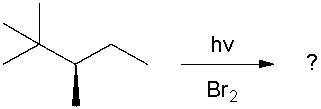A) ![]()
B) ![]()
C) ![]()
D) ![]()
F) All of the above
Correct Answer

verified
Correct Answer
verified
Essay
Upon treatment with NBS and irradiation with UV light, 1-ethyl-4-methylbenzene produces exactly three monobrominated compounds (including stereoisomers). Draw the products of this reaction.
Correct Answer

verified
Correct Answer
verified
Essay
Propose a sequence of reactions to accomplish the following synthesis. 
Correct Answer

verified
1. Br2, light
2. pota...View Answer
Show Answer
Correct Answer
verified
2. pota...
View Answer
Essay
One possible product of thermal cracking of hexane is 1-butene. Draw arrows to suggest a possible mechanism for this process starting from an alkyl radical.
Correct Answer

verified
Correct Answer
verified
Multiple Choice
Which of the following are major products of the reaction shown? 

A) I
B) I, II
C) I, IV
D) I, III
E) I, II, III, IV
G) A) and C)
Correct Answer

verified
Correct Answer
verified
Essay
Propose a synthesis of 1-iodo-2-methylpropane from 2-methylpropene.
Correct Answer

verified
Correct Answer
verified
Essay
Give the arrows to show the mechanism of the following radical process. 
Correct Answer

verified
Correct Answer
verified
Multiple Choice
Which term best describes the process shown below? 
A) neutralization
B) propagation
C) termination
D) initiation
E) elimination
G) A) and B)
Correct Answer

verified
Correct Answer
verified
Multiple Choice
Predict the product(s) of the following reaction. 

A) I
B) II
C) III
D) I, II
E) I, II, III, IV
G) B) and D)
Correct Answer

verified
Correct Answer
verified
Multiple Choice
Which of the following are possible product(s) of the reaction shown? 

A) I
B) I, II
C) I, II, IV, V
D) I, III, IV, V
E) I, II, III, IV, IV
G) A) and C)
Correct Answer

verified
Correct Answer
verified
Essay
Draw the major product(s) of the following reaction. Is the product optically active? Explain. 
Correct Answer

verified
 _TB4454_00 The mixture is not ...
_TB4454_00 The mixture is not ...View Answer
Show Answer
Correct Answer
verified
View Answer
Multiple Choice
Free radical chlorination of ethane can produce higher halogenation products such as dichloroethane, trichloroethane, tetrachloroethane, pentachloroethane, and hexachloroethane. How could the production of higher halogenated products be minimized?
A) use an excess of chlorine
B) use an excess of ethane
C) use equimolar chlorine and ethane
D) it is not possible to minimize the production of higher halogenated products
F) A) and C)
Correct Answer

verified
Correct Answer
verified
Multiple Choice
Which of the following compounds would be expected to be least destructive to the ozone layer?
A) CCl3F
B) CCl2F2
C) CCl2FCCl2F
D) CF3CH2F
F) A) and D)
Correct Answer

verified
Correct Answer
verified
Essay
Give the arrows to show the mechanism of the following radical process. 
Correct Answer

verified
Correct Answer
verified
Essay
Draw the product of coupling of the following radicals. 
Correct Answer

verified
Correct Answer
verified
Multiple Choice
Which of the following is the most stable radical? 
A) I
B) II
C) III
D) IV
E) V
G) B) and E)
Correct Answer

verified
Correct Answer
verified
Multiple Choice
Which term most accurately describes the process shown below? 
A) hydrogen abstraction
B) halogen abstraction
C) homolytic cleavage
D) coupling
E) elimination
G) C) and D)
Correct Answer

verified
Correct Answer
verified
Multiple Choice
Identify an example of termination.
A) homolytic cleavage
B) heterolytic cleavage
C) hydrogen abstraction
D) coupling
E) hydrogen addition
G) B) and E)
Correct Answer

verified
Correct Answer
verified
Multiple Choice
Predict the major product(s) of the reaction shown below. 

A) I
B) II
C) III
D) IV
E) II and III
G) A) and E)
Correct Answer

verified
Correct Answer
verified
Essay
Upon treatment with NBS and irradiation with UV light, 2-isopropyl-3-methyl-1-butene reacts to produce exactly two monobrominated compounds. Draw the products of this reaction.
Correct Answer

verified
Correct Answer
verified
Showing 81 - 100 of 102
Related Exams